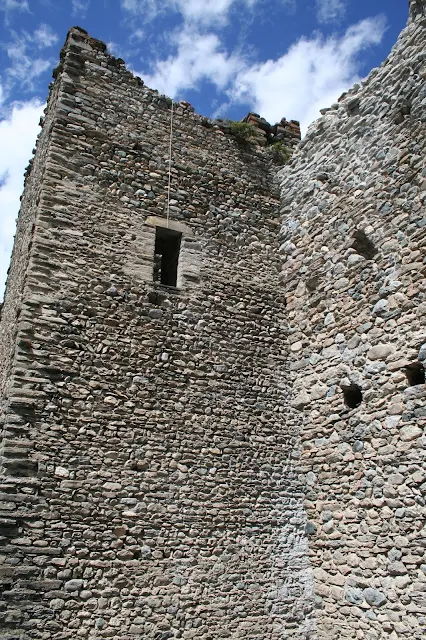 |
Tschanüff Castle is a ruined castle in the former municipality of Ramosch (now Valsot) in the canton of Graubünden in Switzerland. It is a Swiss heritage site of national importance.
History of Tschanüff Castle
The Lords of Ramos first appeared in historical records in the 12th century. They were vassals of the Bishop of Kur and the Lords of Tarasp. The oldest part of the castle is the main tower, which was built as a bergfried (battle tower with no permanent residents) in the 12th century for the Lords of Ramos.
The ring wall was added in the 13th century. On 12 March 1256, the Count of Meinhard of Tyrol granted the knight Nannes of Ramos the right to build a castle on Ramos. Since there was already a fortification here, this resolution probably consisted of expanding the small tower into a much larger castle. The new castle allowed the Ramos family to control trade and taxes throughout the territoryLower Engadine.
 |
| tschanüff castle valsot switzerland |
On August 19, 1317, Nannes and his brother Johannes divided the estate in two. Johannes' successors, Konrad and Schweiker, fell out with each other over their inheritance. The conflict escalated until the Duke of Austria, Leopold, intervened in 1365. The agreement between the brothers said that they both accepted the dukes of Austria as their overlord, the castle was to remain open to the dukes, and if they quarreled again, the castle and the surrounding lands would become the property of Austria.
Despite the difficult conditions, Konrad and Schweiker quickly began fighting again, and in 1367 Schweiker killed Konrad and fled Chanyuf. In gratitude for his service in the Austrian War in Italy, the Duke appointed Ulrich Match the owner of Tschanüff.
 |
| tschanüff castle valsot switzerland |
The Match family took possession of the castle on February 17, 1369. The bishop of Kura also claimed the castle and, fearing the growing influence of Austria in the region, began to confirm his claims. In 1394, Bishop Hartmann forced the Matcha Lords to abandon the castle. However, the following year, Match attacked the castle and plundered it, but retreated when the bishop led an army toward Ramos. In 1421, under a peace treaty, the castle was transferred to the bishop, and the lords of Matcha were paid 2,500 marks for their losses.
Then the bishops appointed the Vogts to rule the valley for the next centuries. In 1468, the castle was attacked by the League of the House of God during a conflict with the bishop. It may have been besieged during Hennencraig in 1475.
 |
| tschanüff castle valsot switzerland |
During the Swabian War of 1499, the bishop's own troops burned the castle to prevent it from falling into the hands of the Emperor. In 1565, rebels against the bishop attacked, looted, and burned the outer chamber. The inhabitants of the Lower Engadine were found guilty of causing damage and ordered to pay for the restoration of the castle. Until the 16th century, the castle was called Ramos or Remus in honor of Lords Ramos. In the 16th century, it became known as Tschanüff, which was Romansh for Casa Nova, or new home. This was to distinguish it from the nearby Servisel Castle.
During the Bündner Wirren in 1622, the castle was captured and burned by troops from Glarus. It was quickly renovated and survived the rest of the turmoil, but was not destroyed. Over the next century and a half, the castle was again used as the seat of the appointed representative of the bishop. It was abandoned in 1780 after part of the castle was destroyed by a landslide.
